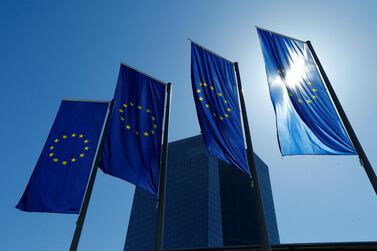Europe’s economy began 2019 with an unexpected burst of growth buoyed by France and Spain, easing pressure on the European Central Bank to add stimulus.
The eurozone's 0.4 per cent increase in gross domestic product during the first quarter reported by Eurostat was twice the pace at the end of last year and more than economists predicted. Strong investment in Spain and buoyant consumer spending in France gave a fillip to expansion in the 19-nation currency bloc.
Spanish gross domestic product expanded by 0.7 per cent in the January to March period from a quarter earlier, above a Reuters forecast and the 0.6 per cent recorded in the previous quarter, the National Statistics Institute said.
Year on year, Spanish gross domestic product rose 2.4 pe rcent, the figures showed, also above a forecast of 2.3 per cent and the largest rise since the third quarter of last year.
Spanish retail sales expanded by 1.7 per cent in March, the fastest pace since October, INE said on Tuesday.
In France, buoyed by French President Emmanuel Macron’s tax cuts in response to the Yellow Vest protests, consumer spending powered the eurozone’s second-largest economy to repeat the 0.3 per cent expansion it recorded in the final quarter of 2018.
While the euro region’s growth rate was below the average of the past five years, it marks the second quarterly acceleration since a downturn in trade and factory activity pulled the economy close to a standstill last summer, according to Bloomberg. The current company reporting season in Europe is also shaping up to be fairly bullish - Airbus’ earnings surged in the first quarter on higher output of its A320 narrow-body jet.
Some countries in the bloc have yet to experience a meaningful turnaround, with Germany expected to see the weakest expansion in six years. The first-quarter figure includes some German data provided to Eurostat by the country’s national statistics office. Official numbers for Europe’s largest economy will be released on May 15.
Business confidence continued to soften in April, and the ECB has already said it won’t raise interest rates this year. Policymakers have expressed mixed feelings about whether a rebound initially penciled in for the second half will pan out. More evidence of weakness across the region could force them to make recently announced stimulus tools more accommodative to support growth.
While resilience in Spain and France provides a brightening picture for the region, external trade conflicts and homegrown difficulties, notably an upheaval in Germany’s car industry, have yet to clear. Still, German unemployment fell 12,000 in April, more than economists expected, to a record low of 2.22 million. The labour agency said demand for workers continues to be very high.
And although Italy has been in recession in the second half of 2018, Italian joblessness slipped to 10.2 per cent in March, the lowest since August. GDP data later on Tuesday will show whether the economic slump there has ended.







